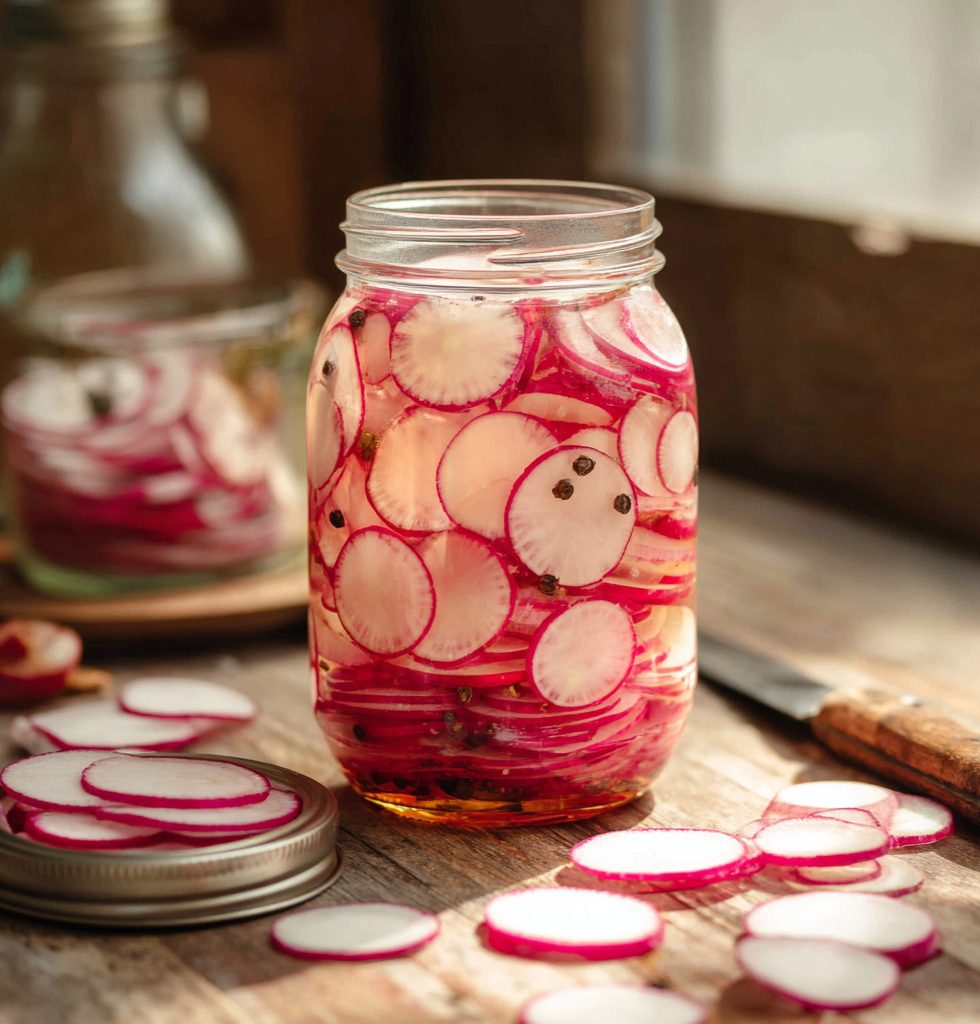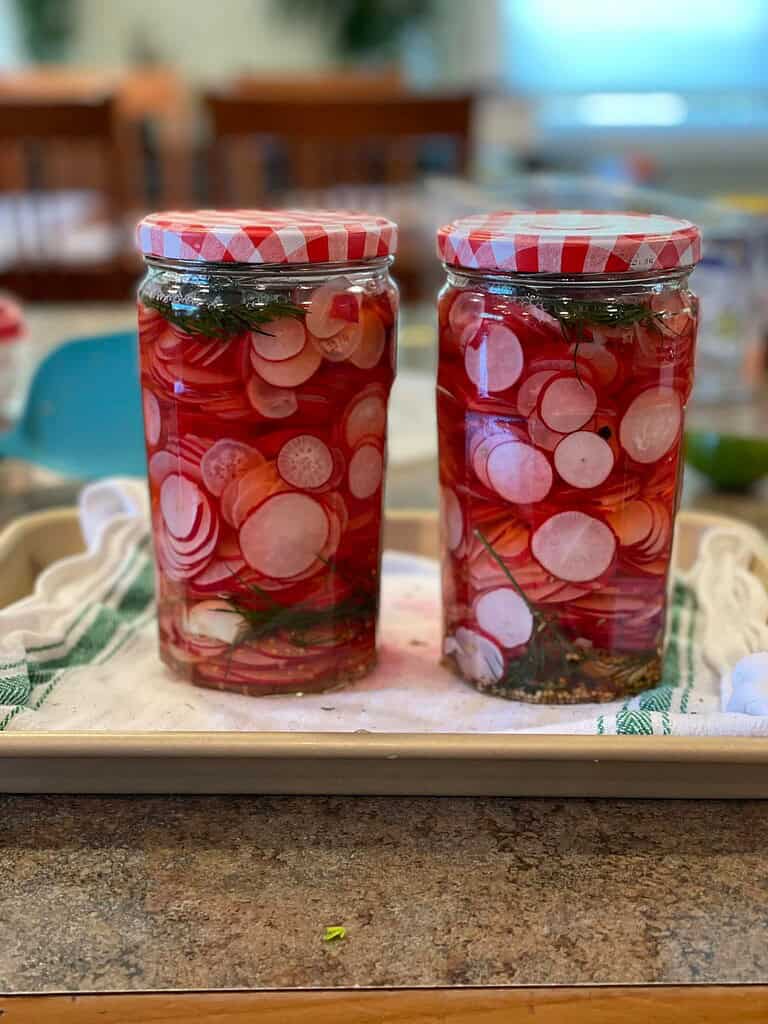Pickled radishes are one of those things that can take a plain meal and make it taste brighter and fresher.
They’re quick to prepare, need only a handful of ingredients, and are ready in as little as an hour if you slice them thin.
The balance of sweet, salty, and sour makes them a versatile topping for tacos, sandwiches, salads, or grain bowls.
Whether you’re topping tacos, adding crunch to sandwiches, or just eating them straight out of the jar, they’re a handy recipe to have in your back pocket.
And if you’re curious about preserving other foods too, this guide to canning for beginners is a great place to start.
What Are Pickled Radishes?

Pickled radishes are fresh radishes that have been soaked in a mixture of vinegar, water, salt, and sugar to create a tangy, slightly sweet, and salty flavor.
The pickling process softens their sharp, peppery bite while keeping their natural crunch.
Unlike raw radishes, which can taste overly bitter to some, pickled radishes have a balanced taste that works well with a wide range of foods.
They are often used as a quick side dish, a topping for tacos, or a colorful addition to sandwiches and salads.
Love Pickling? This is part of my How to Pickle Everything series! Check out more recipes:
- Easy Pickled Beets Recipe
- Homemade Pickled Okra Recipe
- How to Make Pickled Cabbage (Only 20 Minutes!)
- How to Make Pickled Jalapeños at Home
- How to Make Pickled Cucumbers at Home
- Pickled Garlic Recipe
- Easy Pickled Banana Peppers Recipe
- Quick Pickled Carrots Recipe
- How to Make Pickled Asparagus at Home
- How to Make Pickled Ginger (Gari) at Home
- How to Make Pickled Cauliflower
- Crisp Pickled Green Beans Recipe
- Homemade Pickled Eggs with Beets
- Easy Pickled Cherry Tomatoes (No Canning Needed)
Why Make Pickled Radishes?

Pickled radishes are a quick way to add flavor, color, and crunch to everyday meals. The vinegar brine softens their sharp bite, making them more versatile and enjoyable.
Because this is a refrigerator pickle, the radishes should be stored cold and enjoyed within about 2–3 weeks for the best flavor and quality.
Kept submerged in brine and handled with clean utensils, they’ll stay crisp and safe during that time.
With just a few basic ingredients, you can create a tangy, salty, and slightly sweet topping that pairs well with tacos, sandwiches, grain bowls, and salads.
Radishes themselves are naturally low in calories and provide vitamin C and minerals – but the main benefit of pickling is flavor and convenience, not nutrient preservation.
Types of Radishes You Can Pickle

While red radishes are the most common choice, several other varieties can be used for refrigerator pickles. Each brings a slightly different flavor and texture:
- Red Radishes – Mild heat, classic choice, great for thin slices.
- Easter Egg Radishes – Mild, slightly sweet, and colorful.
- Watermelon Radishes – Less peppery, sweeter flavor, striking appearance.
- Daikon Radishes – Firm, stay crunchy; good for cubes or sticks.
- Korean Radishes (Mu) – Dense and crunchy, often used for cubed pickles in Korean cuisine.
Food Safety Note: The National Center for Home Food Preservation does not provide a tested water-bath canning process for radishes.
These should be made and stored as refrigerator pickles only. Keep jars refrigerated and consume within 2–3 weeks for best quality and safety.
Always ensure radishes are fully submerged in brine and use clean utensils when serving.
How Long Do Pickled Radishes Take to Be Ready?
The time it takes for radishes to absorb the brine and develop full flavor depends on how they are cut. Thin slices soak up flavor quickly, while larger pieces need more time.
| Cut Style | Time to Be Ready |
|---|---|
| Thin slices | Ready in as little as 1 hour after chilling. |
| Halves | Best after 12–24 hours in the refrigerator. |
| Cubes (Korean style) | Fully flavored in 1–2 days. |
For the best taste, always let the radishes rest in the refrigerator after the initial room temperature setting time, even if they’re thinly sliced.
Ingredients (1 pint)
- 1 bunch radishes (about 18–20 medium), thinly sliced
- ½ cup 5% vinegar (white distilled or cider)
- ½ cup water
- 1–2 Tbsp sugar (optional; to taste)
- 1 tsp canning/pickling salt (iodized table salt is safe but can cloud brine)
- Optional add-ins: ½ tsp mustard seed, ½ tsp peppercorns, 1 small garlic clove (sliced), pinch red pepper flakes, a few sprigs dill/thyme.
Equipment
- Small non-reactive saucepan (stainless, glass, or unchipped enamel)
- Clean glass pint jar with lid
4 Steps to Make Quick Pickled Radishes (Refrigerator Pickles Only)

Making quick pickled radishes is simple and safe when done the right way. This recipe is designed for refrigerator storage only.
Step 1: Prepare the Radishes
Wash 1 bunch radishes (about 18–20 medium) thoroughly.
Trim tops and roots, then slice thin for faster pickling. For a crunchier bite, cut into halves, cubes, or matchsticks (these will need longer to absorb brine).
Pack radishes into a clean pint-size glass jar (not sterilized, just washed well). Leave space at the top for brine to fully cover them.
Step 2: Make the Brine
In a small non-reactive saucepan (stainless steel, glass, or unchipped enamel), combine:
- ½ cup 5% vinegar (white distilled or apple cider)
- ½ cup water
- 1–2 tablespoons sugar (optional, to taste)
- 1 teaspoon canning/pickling salt (table salt is safe but may cloud brine)
Warm gently, stirring until sugar and salt dissolve. You may pour the brine hot (for slightly longer storage) or let it cool before using (for crisper radishes).
Step 3: Add Flavor Enhancements
Add optional spices directly to the jar: mustard seed, peppercorns, dill, garlic, or red pepper flakes.
Step 4: Combine and Chill
Pour brine over radishes until fully submerged. Seal the jar tightly and place immediately in the refrigerator.
- Thin slices: flavorful within 1–2 hours
- Larger pieces: best after 24–48 hours
For best quality, enjoy within 2–3 weeks, always keeping radishes submerged and using clean utensils to avoid contamination.
How Long Can Pickled Radishes Be Stored?

Because there is no tested canning process for radishes, this recipe is for refrigerator pickles only.
- Do not reuse brine to make another batch of pickles. Once the radishes are eaten, leftover brine may be used within a day or two as a marinade or salad dressing, but it should then be discarded.
- Store the jar in the refrigerator immediately after preparing.
- For best flavor, texture, and safety, enjoy within 2 to 3 weeks.
- Always keep radishes fully submerged in the brine and use clean utensils when serving to avoid introducing bacteria.
Enjoy Your Homemade Pickled Radishes!
Pickled radishes are a quick and easy way to add a burst of tangy flavor and satisfying crunch to any meal. With just a few ingredients and minimal effort, they can be ready in as little as an hour.
Whether paired with tacos, mixed into salads, or served alongside roasted meats, they bring both color and flavor to the table.
Keep a jar in the refrigerator to have a versatile topping ready whenever a dish needs a fresh, zesty touch.
Frequently Asked Questions
1. Can I pickle other vegetables with radishes in the same jar?
For refrigerator pickles, yes – you can add vegetables like carrots, onions, or cucumbers, cut to similar sizes so they flavor evenly.
For canning, no – NCHFP warns that only vegetables listed in a tested recipe should be used, since safety depends on the correct vinegar-to-water ratio and processing time.
2. What’s the best vinegar for a less sharp taste?
Use only vinegar labeled 5% acidity. White distilled vinegar gives the sharpest flavor, while apple cider vinegar is milder and slightly fruity.
Rice vinegar is only safe if it is labeled 5% acidity – many brands are weaker and should not be used for pickling.
3. Can pickled radishes be canned for long-term storage?
No. The National Center for Home Food Preservation does not have a tested canning process for radishes, so this recipe must remain a refrigerator pickle.
Always store cold and consume within 2–3 weeks.
4. Why did my pickled radishes turn soft or mushy?
Likely reasons include pouring brine that’s too hot, using older or over-mature radishes, or storing them past their best window. Use fresh, firm radishes and avoid prolonged storage to keep them crisp.
5. Can I make pickled radishes without sugar?
For refrigerator pickles, yes – you can reduce or omit sugar, or use a sugar substitute for flavor.
